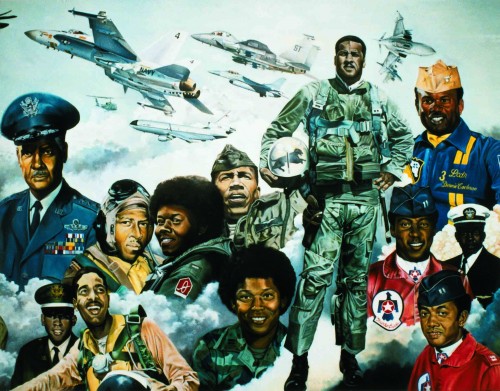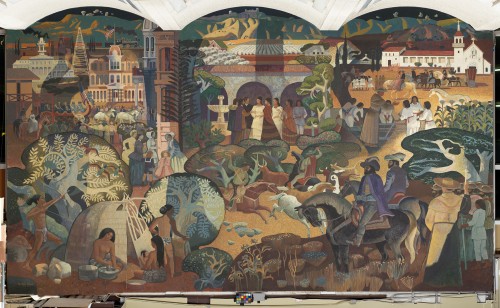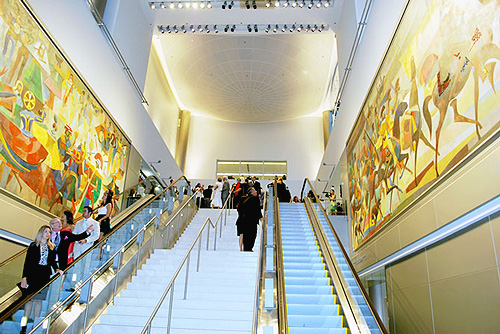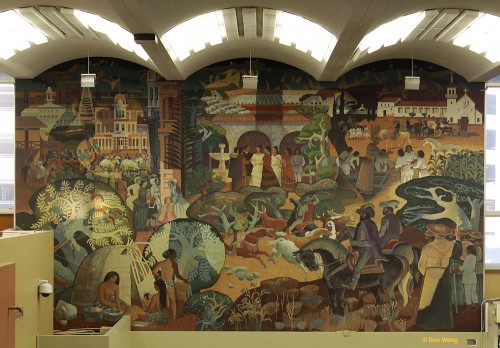This month, my “At the Airport” column on USATODAY.com profiles some significant murals at airports around the country.
Here are few; more tomorrow…
When Lambert-St. Louis International Airport celebrated the re-opening of its tornado-damaged Concourse C on April 2nd, passengers were greeted with fresh shops and restaurants and a half-dozen new works of art.
But many community members had gathered weeks earlier to honor a 22-year-old piece of airport-owned art.
On February 16, the St. Louis airport re-dedicated “Black Americans in Flight,” a multi-panel mural measuring 8 feet tall and 51 feet long that pays tribute to African-American achievements in aviation. Painted in 1990 by local McDonnell Douglas employees Spencer Taylor and Solomon Thurman, the mural includes 75 portraits, 18 aircraft, three American Bald Eagles, five unit patches and one spacecraft.
“Our airport is going back to its original vision and trying to be a cultural institution as well as a utilitarian one,” said Lambert spokesperson Jeff Lea, “We think it’s important that when people come to our airport they see a piece of history and major artwork they are not going to see in any other airport.”
Other airports around the country have rescued and restored historically significant murals as well.
San Jose
Shortly after the new Terminal B opened at Mineta San Jose International Airport in 2010, workers began demolishing the old Terminal C, which contained a 20-by-30 foot mural by noted California artist Millard Sheets.
Commissioned by the San Jose Mercury News in 1977, the site-specific mural marked San Jose’s 200th birthday and depicts San Jose history, from the earliest Native Americans through the Spanish settlers, the orchards, and early industry.
“Preserving and moving the mural was no easy task,” said Mary Rubin, senior project manager for the public art program in San Jose. The artwork was adhered directly to the sheetrock with a very strong adhesive that conservators at first decided was impossible to remove.
Removing the mural with the wall was considered, but Rubin said, “Luckily it turned out the mural could be peeled from the wall with minimal damage.”
In February, 2011, after several months of restoration, the mural was reinstalled at the airport’s international gates.
Miami
Two iconic, six-ton murals by Brazilian artist Carybé that were displayed for years in the American Airlines terminal at JFK Airport in New York are now at Miami International Airport.
“Rejoicing and Festival of the Americas” and “The Discovery and Settlement of the West” were created as site-specific work in 1960, but the massive murals, each almost seven high and 53 feet long, were destined for demolition along with the terminal. A rescue campaign resulted in the murals (and the walls behind them) being cut into panels for removal and restoration, trucked to Miami and, in 2009, installed to great fanfare in the South Terminal H at Miami airport.
“We’ve brought a bit of art and aviation history to the airport,” said Yolanda Sánchez, MIA’s fine arts & cultural affairs director. “They’re important culturally as well because we consider Miami to be the capital of the Americas and these murals tell passengers they’ve arrived in a city that welcomes all of these different cultures. It’s a perfect match.”
Tomorrow: murals at airports in Cincinnati, Tampa, Baltimore, Lexington, Kentucky and beyond.
Did I miss your favorite? Please add it to the comments section below.




